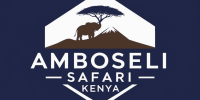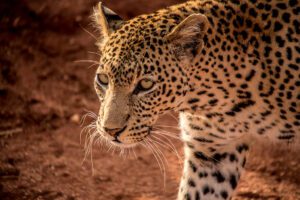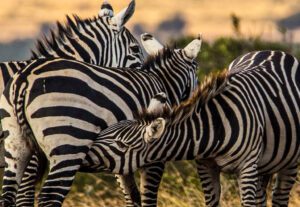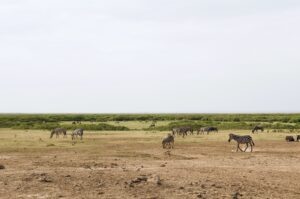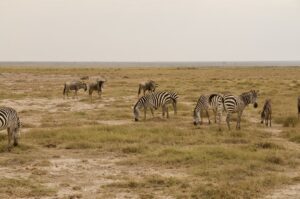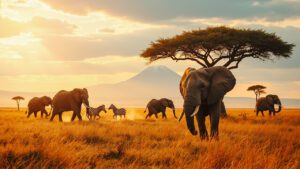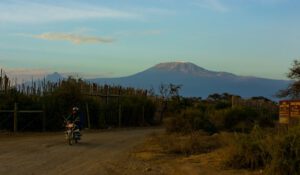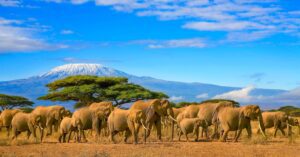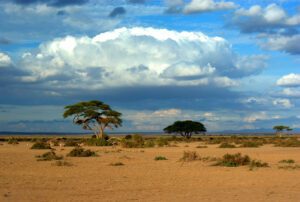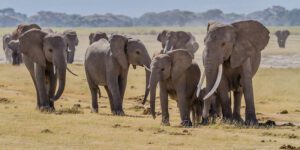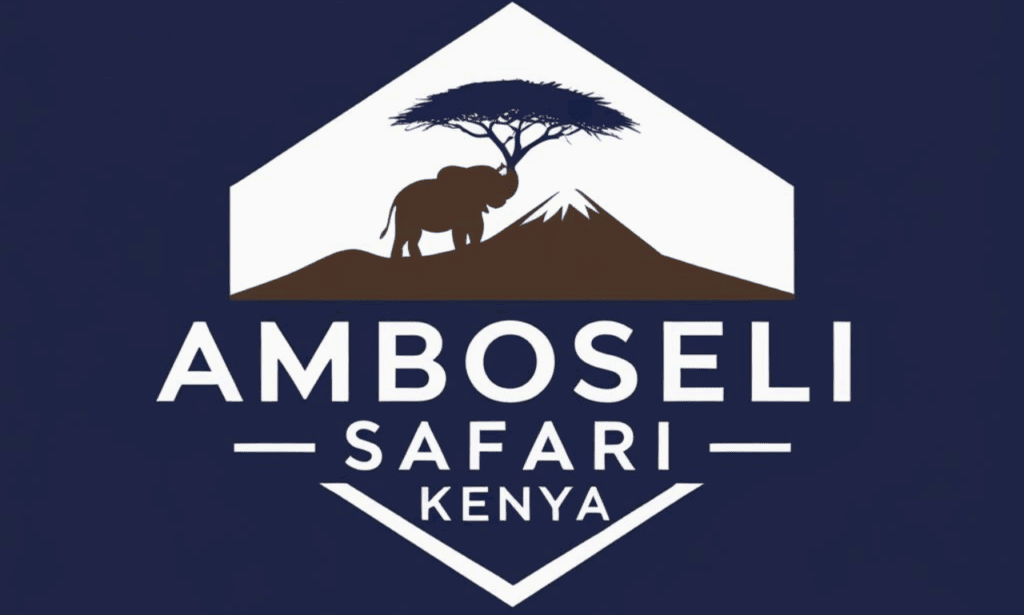What is the best time of year to visit Amboseli National Park for wildlife viewing?
The best time to visit Amboseli National Park for wildlife viewing is during the dry season, which runs from June to October and also in the months of January and February. During this time, the weather is dry, and because there is little to no rain, water sources become limited. This makes it easier to spot animals, as they gather around the remaining waterholes, rivers, or swamps in the park. You won’t have to search far to see large herds of elephants, zebras, or even predators like lions and cheetahs because they’re concentrated near these areas.
Another reason the dry season is perfect for wildlife viewing is the lack of tall grass. When vegetation is low, it’s much easier to see animals as they roam the open plains. In contrast, during the wet season, the vegetation is denser, and animals can sometimes stay hidden. Additionally, there are fewer mosquitoes in the dry season, which makes the experience more comfortable overall.
For example, if you’re visiting Amboseli in August, you could see hundreds of elephants walking across the plains with Mount Kilimanjaro as the stunning backdrop. Wildlife viewing during this time often feels like being in a nature documentary because of how active and visible the animals are.
So, if your goal is to witness incredible wildlife, stick to the dry months. Bonus: The clear skies during this season also make for great views of Mount Kilimanjaro and better opportunities for photographs!
How does the weather change throughout the year in Amboseli National Park?
The weather in Amboseli National Park can be divided into two main seasons: the dry season (June-October and January-February) and the wet season (November-December and March-May). These weather patterns are determined by rainfall and temperature changes each year.
During the dry season, the park becomes very hot and dry, but the skies are generally clear and sunny. Daytime temperatures average between 28°C and 33°C (82°F to 91°F), while nighttime temperatures can drop to around 15°C (59°F). The atmosphere is dusty, but because there’s no rain, the roads and trails stay in good condition, making it easier to move around and spot wildlife.
The wet season is divided into two parts: the short rains (November-December) and the long rains (March-May). During these seasons, the weather is humid, and you’ll experience regular bursts of rain. These rains help revive the landscape. By April, the park is covered in lush green vegetation, which may make spotting animals slightly harder as they blend into their surroundings. Temperatures during the wet season are generally warmer, staying between 30°C (86°F) during the day and 20°C (68°F) at night.
It’s also worth noting that the terrain becomes muddy and slippery during heavy rains, which can sometimes make driving on the roads more challenging. However, the wet season also has its benefits. It’s the perfect time for birdwatching since many migratory bird species visit Amboseli, and the fresh greenery offers stunning photographic opportunities.
In short, Amboseli’s weather transitions between hot and dry months for easy wildlife viewing, and wet, lush months for vibrant landscapes. Understanding these shifts can help you decide which experience you’d prefer.
What are the dry and wet seasons in Amboseli National Park?
Amboseli National Park has distinct dry and wet seasons, making it easier to plan your visit based on what you’d like to experience.
The dry season occurs from June to October and also in the months of January and February. These months are marked by very little to no rainfall. The dry season is famous for its fantastic wildlife viewing because animals gather around water bodies. As the park dries out, the landscape becomes more open, vegetation is thinner, and you can easily spot animals on the golden plains.
The wet season, on the other hand, is split into two parts: the short rains (November-December) and the long rains (March-May). During this time, the park receives significant rainfall. This season transforms the park into a lush, green paradise, and while wildlife might be slightly harder to spot due to thick vegetation, the park becomes vibrant with color. It’s also the best time to see baby animals, as many species give birth after the rains when food is plentiful. Additionally, migratory birds from around the world arrive at Amboseli during the wet season, making it heaven for birdwatching enthusiasts.
Keep in mind that while the rains bring life to the park, they also bring challenges. Flooded roads and muddy tracks can make it more difficult to get around, and dense vegetation can sometimes block your view of wildlife.
To summarize: if you enjoy clear weather and excellent wildlife spotting opportunities, the dry season is ideal. But if you’d like a greener, less crowded experience full of birdwatching and infant animals, the wet season may be perfect for you.
When is the best time to see Mount Kilimanjaro clearly from Amboseli?
The best time to see Mount Kilimanjaro clearly from Amboseli National Park is during the dry months, specifically January to February and June to October. This is because the skies are usually clearer during these times, as there is less moisture in the air and minimal chances of rain creating clouds that can obscure your view. Amboseli is famous for being one of the best places in the world to take in the majestic sight of Kilimanjaro, particularly in the early mornings or late evenings when the light is soft, and the mountain is often framed by beautiful skies.
For instance, if you wake up early, you might catch the glorious sunrise casting a golden glow over the mountain, making it an incredible scene for photography or simply to enjoy. During the wetter months, such as March to May and November, clouds often gather around Kilimanjaro, making it much harder to get a clear view. Visitors might feel disappointed if their main goal is to see the iconic peak during these times.
So, if you’re planning to visit Amboseli and hope to see Kilimanjaro in all its splendor, those dry months are your best bet. Just remember to set your alarm early since clear views are more frequent at dawn before the day warms up and clouds tend to gather.
How does the presence of wildlife vary during different times of the year?
The presence of wildlife in Amboseli National Park changes with the seasons due to water availability, which significantly affects where animals move. Amboseli is famous for its large herds of elephants, and these majestic creatures can be seen in the park pretty much year-round. However, the dry and wet seasons influence the behavior and distribution of other animals.
During the dry season (June-October and January-February), water sources shrink, and animals concentrate around the park’s permanent swamps and waterholes. This means that wildlife sightings are more predictable and easier for visitors. Lions, zebras, wildebeests, giraffes, and antelopes can often be seen gathering in these areas to drink and feed. Predators like lions and hyenas take advantage of this and can often be spotted hunting near the water sources.
In the wet season (March-May and November-December), rain increases vegetation, and animals spread out into the broader ecosystem since water is now widely available. This can make spotting wildlife trickier because the animals are not confined to a few places. However, this is also when the park looks incredibly lush and green, and it’s a prime time to spot baby animals as many species give birth following the rains. Migratory birds also arrive during the wet season, making it a spectacular time for birdwatching.
In summary, the dry season is better for higher chances of seeing grouped animals near water, while the wet season offers a different, greener experience with newborn animals and vibrant birdlife.
Are the roads and infrastructure in Amboseli affected by seasonal weather?
Yes, the roads and infrastructure in Amboseli National Park are affected by seasonal weather, especially during the wet season. Most of the park’s roads are unpaved and consist of dirt tracks, which can become muddy and even impassable after heavy rains. The wet season, which lasts from March to May and again in November, brings heavy rains that can flood certain areas. Visitors might find themselves struggling to navigate slippery or waterlogged paths unless they are traveling in a sturdy 4×4 vehicle designed for such conditions.
For example, some safari operators make adjustments during these months by using vehicles equipped for off-road conditions and avoiding areas prone to flooding. However, even with precautions, certain spots might still be temporarily inaccessible, and travel can take longer, requiring patience and flexibility.
On the other hand, during the dry season (June to October and January to February), the roads are much easier to traverse since they are not bogged down with mud, and the dry terrain makes navigation simpler. The infrastructure, such as camps and lodges, is usually fully operational during this period, as the risk of weather-related disruptions is minimal.
Despite these challenges, many travelers find the wet season worthwhile because of the fewer crowds, lush landscapes, and the unique atmosphere of a greener Amboseli. If visiting during the rainy months, travelers should check road conditions in advance, pack proper gear like raincoats, and book with operators experienced in navigating the park under such conditions. For a hassle-free experience, though, the dry season remains the best choice for road conditions and overall ease of travel.
When is the park less crowded with tourists?
The best time to visit Amboseli National Park when it is less crowded is during the low or off-peak tourism seasons, which generally correspond to the rainy or wet seasons. Amboseli’s low season typically occurs in April, May, and November, the months when rainfall is more frequent, making it less appealing to many tourists who prefer dry weather or guaranteed easier wildlife viewing.
During the rainy seasons, you’ll see fewer safari vehicles in the park, and the lodges or camps tend to be less busy with visitors. This means you can enjoy a quieter, peaceful experience with the natural environment. The roads may be muddier or more challenging during this time (some are inaccessible in heavy rains), but if you’re prepared for these conditions, you can relish having more of the park to yourself. For example, observing elephants or other animals moving across the open plains without numerous safari vehicles congregating around is a very special and tranquil experience.
Additionally, prices for accommodations and safari tours are often lower during these less crowded periods, as the demand is reduced. For visitors who don’t mind the possibility of a little rain, these months offer a more personal and exclusive safari experience.
In contrast, the park is busiest during the dry seasons (June to October and late December to March) because these months provide better weather and excellent wildlife viewing. People flock to Amboseli during this time, so if you’re looking to avoid crowds and want quieter game drives, the low/rainy season is a great choice.
Are there specific months ideal for birdwatching in Amboseli National Park?
Yes, Amboseli National Park is a haven for birdwatchers, and the best months for birdwatching are during the wet seasons, particularly from November to April. During this time, the park is teeming with activity as many migratory bird species arrive, joining the resident birds of Amboseli.
In these months, you’ll be able to see a wide variety of birds, including species that migrate from Europe and Northern Africa to Amboseli. For example, you might spot vibrant yellow wagtails, Eurasian rollers, and other striking migratory birds that enrich the park’s diversity. The wetlands and swamps within the park, such as the Enkongo Narok Swamp, become especially active with waterbirds like flamingos, herons, pelicans, and egrets gathering in large numbers.
The rainy season also makes the vegetation lush, increasing the availability of insects, seeds, and other food sources for the birds. This abundance of food supports their nesting and breeding activities, so you might even get the chance to see colorful mating displays and hear their songs.
Resident bird species like ostriches, African jacanas, and secretary birds can always be seen year-round, but the wet season’s additional migratory birds make this period especially rewarding for birdwatchers. You can watch birds from your safari vehicle, near waterhole areas, or with a simple guided walk around the park’s bird-rich areas.
It’s important to note that while birdwatching is excellent during the wet months, the same rains that bring the birds can make the roads muddy and less accessible. Having waterproof gear and binoculars is essential during this time to enhance your experience.
How do seasonal pricing and accommodation availability affect travel plans?
Seasonal pricing and accommodation availability have a significant impact on planning a trip to Amboseli National Park, as they can determine your budget, itinerary, and overall experience. Pricing and availability are largely influenced by the low/rainy season (off-peak) and the high/dry season (peak).
High season (June-October and December-March): This is when Amboseli is at its busiest. The dry season offers the best wildlife viewing, as animals gather around water sources, and vegetation is sparse, making them easier to spot. As a result, accommodation prices are at their highest, and lodges or camps can book up months in advance. Tour operators also charge higher rates during this time due to the demand. For example, you may find that luxury lodges or camps charge significantly higher per night in August than in May. If budget isn’t an issue, this is a great time to visit, but you’ll need to book early to secure your preferred accommodations or safari extras like hot air balloon rides.
Low season (April-May and November): This is when prices for accommodations and safari packages drop significantly. Many camps and lodges offer discounts to entice visitors. More rooms are available, so you have a greater chance of securing a beautiful lodge or tent with fewer crowds and stress. However, some accommodations may close temporarily during the most intense rainy periods, so your options might be slightly more limited.
For visitors with flexibility, the shoulder seasons (early June or late October) can be ideal. These times are less crowded than mid-peak season, and prices may be lower without compromising weather or animal activity.
In summary, seasonal pricing and accommodation availability can be optimized if you’re flexible, plan ahead, and carefully choose the time of year based on whether you prioritize affordability or optimal weather.
What time of year offers the best photographic opportunities in Amboseli?
The best time of year for photography in Amboseli National Park is during the dry season, which typically runs from June to October and again in January and February. During these months, the landscapes are striking, the wildlife is abundant, and Mount Kilimanjaro, which is one of the park’s most iconic features, is often visible with minimal cloud cover, providing a stunning backdrop.
In the dry season, most grass and vegetation are sparse, so animals commonly gather around limited water sources, like swamps and watering holes. This not only makes it easier to spot wildlife but allows for close-up, action-filled shots of predators, elephants, zebras, giraffes, and more interacting in their natural habitats. For instance, capturing an image of a herd of elephants crossing the barren savannah with snow-capped Mount Kilimanjaro in the background is a classic Amboseli postcard moment.
Additionally, the lighting during the early mornings and late afternoons in this season tends to be softer, creating vibrant sunrise or sunset hues. Wildlife photographers often call this the “golden hour,” as it beautifully enhances the natural tones of animals and the landscape.
On the other hand, while the wet season (March to May and November to December) can also offer unique photographic opportunities, it is less predictable. The rainy season can bring lush greenery and dramatic storm cloud formations, which create a different kind of beauty. However, challenges like muddy roads and sporadic animal dispersal due to abundant water sources may make photography slightly more challenging.
Photographers should also bring proper camera equipment to capture both wide-angle landscapes and zoomed-in shots of details like an elephant’s wrinkly skin or a lion’s flowing mane. Investing in waterproof gear is vital if visiting in the wet season. No matter the season, Amboseli offers incredible opportunities, but the dry season is generally ideal for capturing its iconic, magazine-worthy images.
Are there any unique events or seasonal activities that occur in Amboseli?
Amboseli, while known primarily for its incredible wildlife, does offer some unique seasonal sights and events tied to the natural lifecycles of the animals and local culture. These activities and experiences differ depending on when you visit.
One of the most notable seasonal events occurs during the wet season (March to May and November to December), when the short rains and long rains dramatically transform the landscape. The once-dusty plains turn into a lush green paradise, attracting migratory birds from Europe, Asia, and other parts of Africa. This makes the wet season especially ideal for birdwatching enthusiasts. Visitors can spot flamingos, pelicans, herons, and storks. The wet season also coincides with calving season for many herbivores like zebras and wildebeests, meaning visitors may have the chance to see young animals with their mothers as well as predators lurking nearby for easy prey.
On a cultural front, travelers visiting nearby Maasai communities can observe seasonal practices and celebrations. For example, pastoralist Maasai people often conduct traditional rites or Maasai dances that align with certain times of the year or changes in the environment.
Another noteworthy seasonal activity is witnessing the elephant migration. Though elephants roam freely in Amboseli year-round, their movement increases during the dry season (June to October). Herds migrate across the park’s borders, seeking water and food. This migration offers an extraordinary sight of these majestic creatures traveling in unison.
The transitions between seasons themselves offer unique experiences. For example, seeing thunderstorms rolling over the plains at the end of the dry season right before the rains begin feels both dramatic and magical.
While Amboseli does not formally host festivals or human-led events, the seasonal rhythms of nature create their own fascinating spectacles for visitors. These moments offer unforgettable glimpses into how life survives and thrives in a truly wild ecosystem.
What precautions should visitors take during different seasons in Amboseli?
Visiting Amboseli National Park during different seasons requires preparation to ensure a safe, comfortable, and enjoyable trip. The dry and wet seasons present unique challenges and precautions every traveler should consider:
Dry Season (June to October, January to February):
During the dry season, temperatures can get very high during the day, so it’s essential to protect yourself from heat and dehydration. Wear light, breathable clothing and a wide-brimmed hat, and always apply sunscreen. Drink plenty of water to stay hydrated while exploring the park.
The dry season is also very dusty, so packing a scarf or face mask to cover your nose and mouth can be helpful, particularly on safari drives where roads may stir up dirt. If you wear contact lenses, bring eye drops to avoid discomfort.
Although it’s generally a safer season to visit in terms of weather, wildlife viewing allows close encounters during this time. Always observe animals at a safe distance and follow your guide’s instructions to avoid any danger.
Wet Season (March to May, November to December):
During the wet season, the biggest challenge is the rain. Roads can become muddy and difficult to navigate, which means having a 4×4 vehicle is absolutely necessary. Visitors should pack waterproof attire, including a jacket, boots, and a poncho, as well as covers for cameras or electronics to protect them from water damage.
Mosquitoes and other insects thrive during the wet season, so it’s vital to use insect repellent and wear long-sleeve shirts and pants to minimize bites. You should also ensure you are up to date with any malaria prophylaxis or vaccinations needed for your trip.
Additionally, heavy rains may limit certain safari activities or visibility, which could slightly alter your plans. Maintain flexibility in your itinerary and prepare for potential weather-related delays.
General Precautions for All Seasons:
Regardless of when you visit, always follow safety guidelines, such as staying inside your vehicle during game drives and avoiding feeding or getting too close to animals. Work with reputable guides who understand the park’s rules and the behavior of its wildlife.
Both seasons in Amboseli offer extraordinary experiences, but being prepared, whether for heat, dust, or rain, will help maximize your comfort and minimize risks during your visit.
